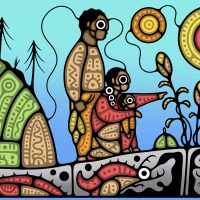The National Day for Truth and Reconciliation is an important day for reflecting on what needs to be done to advance reconciliation in Canada. It can also tell us something important about how Canadian and Indigenous governments can work together to develop policy to address the climate crisis in a way that reconciles Canada’s relationship and power imbalance with Indigenous Peoples and with the Land. At its core, good climate policy (i.e. policies that reduce greenhouse gas emissions and help communities adapt to climate change) should be founded on healthy relationships between humans and the natural world, including non-human kin.
First observed on September 30, 2021, the National Day for Truth and Reconciliation, or Orange Shirt Day, honours First Nations, Inuit, and Métis survivors of the institutions known as residential schools, as well as the children who never returned home. For over a hundred years, Indigenous children were forcibly removed from their Land, communities, families, and cultures, and were placed in institutions run by the Canadian government and the Roman Catholic, Methodist, and Anglican churches. This was done through a federal government and church policy that Pope Francis recently acknowledged amounted to genocide. At the policy’s peak, 139 Indian residential schools were in operation. In these institutions, there was little to no visitation for families, siblings were often separated, and a prohibition on speaking Indigenous languages was strictly enforced. The last school didn’t close until 1996, and many communities are still grappling with the long-term effects on their languages, cultures, and well-being, particularly as the confirmation of unmarked graves continues to dominate media headlines.
However, the legacy of colonialism in Canada, and therefore the work of reconciliation, extends far beyond any government-mandated schoolyard. Policies that compounded the harm of residential schools remain largely entrenched in Canadian legislation today. The Indian Act, drafted in 1876, is still in place, and contributed to the banning of cultural practices, forced relocations, and further efforts to remove Indigenous people from the Land.
Approximately one third of the Indian Act pertains to Land resources and the environment. The imposition of Western resource management practices in place of traditional Land stewardship practices over the last century and a half has effectively continued what the Canadian government set out to do back in the 1870s, which was to remove Indigenous people from their Lands and assimilate them in order to pursue resource development.
In a year when wildfires were far worse than any previous year on record and Indigenous communities in particular were heavily displaced, fire suppression policies are increasingly being recognized as part of the problem, and Indigenous knowledge is being called upon as a solution to protect people, communities, and ecosystems from the consequences of climate change. This is exemplified through Indigenous-led initiatives such as prescribed fire burning and guardian watchmen networks.
We are also seeing Indigenous leadership and practices integrated into other climate policy areas like clean electricity, major project development, climate activism, and economic leadership. However, despite the resurgence of Indigenous knowledge, there is still a long way to go before meaningful reconciliation and power sharing define the climate policy space.
There is an historic and ongoing lack of inclusion of Indigenous Peoples at climate policy tables where decisions are being made. This must change. Including Indigenous worldview, expertise, and knowledge in climate policy will not only strengthen the path to reconciliation but also our relationship to the Land and to all non-human entities that rely on the Land, by promoting balance, respect, and reciprocal relationships.
Western governments are signaling their intent to do things differently in the future. In the 2030 Emissions Reduction Plan, published in July 2022, the Government of Canada committed to Indigenous-led climate policy as a cornerstone of transitioning to a net zero future. Meaningful reconciliation, however, goes a step beyond the add-and-stir method of Indigenizing climate policy currently being used. True reconciliation within the climate space will mean involving Indigenous Peoples and Knowledge Holders as leaders and rights holders, in full control of their knowledge systems, rather than as stakeholders that must merely be consulted. Deeper respect and understanding of Indigenous knowledge and teachings, and their increased representation in decision-making processes, will allow Indigenous people to feel safe enough to know that protocols will be followed and that their knowledge and wisdom will not be misused.
On this day of commemoration, we want to ground our hearts and minds in healing as we think of the transformative change that is required to heal relationships with one another and the Land. To do this we can embody the words of Christina Hoicka, Alicia Campney and Katarina Savic: “reconciliation is about the genuine restructuring and transformation of the relationships between Indigenous and settler people.” This insight challenges us to ensure that not only are Indigenous people seated at the table where climate policy decisions are being made, but that Indigenous people decide how that table is set.








